Early SUVs could handily venture off the road, carry your stuff, or tow your trailer. But on-road performance and handling generally weren't part of the bargain. Then their market success enticed even BMW and Porsche to create tall, high-riding vehicles that an open-minded driving enthusiast might enjoy. To the horror of less open-minded enthusiasts, these creations sold well.
Beforehand, Land Rover had owned the Euro-badge SUV segment. To properly defend its territory, the storied British marque needed something akin to the new German machines. So, for the 2006 Range Rover Sport (RRS), Land Rover rebodied an LR3 (a.k.a. Discovery) chassis to deliver much of the style and luxury of the range-topping Range Rover. Alas, sportier suspension tuning being quite relative, the RRS fell well short of the BMW X5 (much less the Porsche Cayenne) in on-road capabilities. During a drive of the 2006, my predominant impression was "ponderous." Granted, sport takes many forms, but to a driving enthusiast the suffix didn't seem warranted.
Eight years later, both the Range Rover Sport and the X5 have been redesigned, so I drove each for a week (X5 review). To my astonishment, between BMW's pursuit of a broader market and the continued innovation of the plucky little Indo-British firm, the tables have turned.
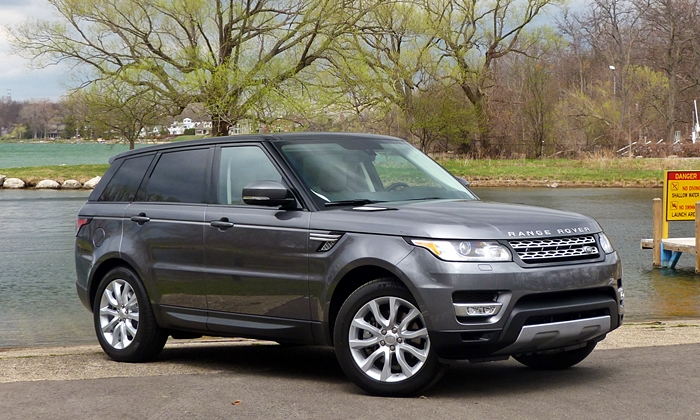
Does anyone else offer an SUV as attractive as this one? more Range Rover Sport photos
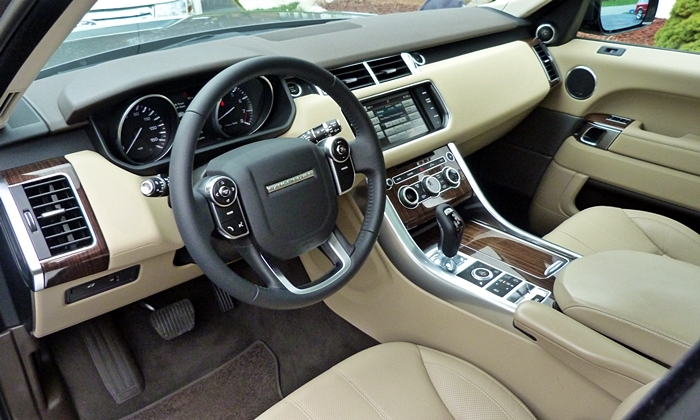
Nothing bizarre, and yet clearly the work of a skillful designer.
| |
Compared to the X5 |
| Brand reputation & image |
 Better
Worse
Better
Worse
|
Nothing against the latest redesign--it's quite impressive--but the Range Rover Sport's attractions begin with what's decidedly not new: Land Rover's traditional focus on SUVs. Land Rover doesn't build sports car or sedans (though sister Jaguar does). Instead, like Jeep in the U.S., Land Rover focuses on off-road vehicles because that's what it has always done.
In contrast, the German parvenus wouldn't bother with the things if they weren't so popular and profitable. If you're willing to pay the price they'll build you an SUV (or a crossover, if you prefer that term for the more car-like sort), even a very good one (if you check the right boxes), but their heart and soul aren't in it.
Then there's the matter of what Land Rovers were developed to do in the postwar period, and who they were developed to do it for. No, not trips to the mall for suburban housewives. When the Queen and landed gentry of England toured their estates, they did so in Land Rovers. And when the Queen's subjects had to venture through the largely unpaved reaches of her vast, increasingly former empire, they ventured in Land Rovers. Mutual of Omaha didn't introduce American children to Africa's wildlife from the seat of a BMW. Buy a Range Rover, and you're gaining a connection to these traditions.
Plus some exclusivity. Land Rovers sell in much smaller volumes than the big German makes. Between this and their idiosyncracies, they seem more special.
| Exterior styling |
 Better
Worse
Better
Worse
|
A tight focus on SUVs means that your styling can be optimized for their tall, high-riding proportions and traditional applications, not adapted from whatever you've been doing with your cars. Range Rovers, the upscale offshoots of Land Rovers, have always been handsome vehicles, and the latest are the most attractive yet. Though the new Range Rover Sport's basic shape remains quite square, and maintains a clear visual link with the original 1970 Range Rover, near-perfect proportions and subtly curved lines and surfaces form an artful whole that is at once classic and thoroughly up-to-date.
The Range Rover Sport can be fitted with lower profile tires than the 255/55R20s on the tested HSE. But the look remains unapologetically that of an SUV, and aesthetically it doesn't require them.
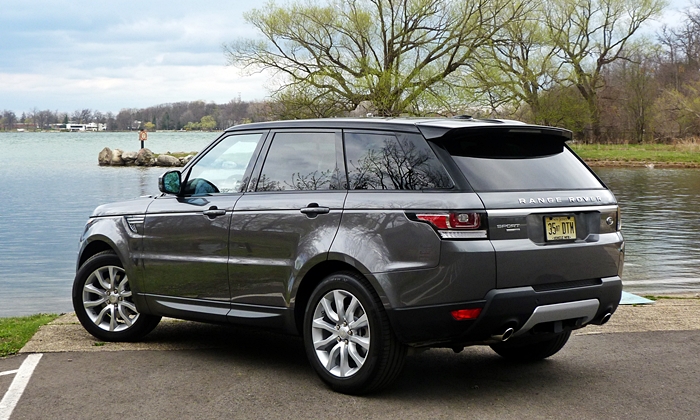
Tapered tail and flared fenders make for a sporty box.
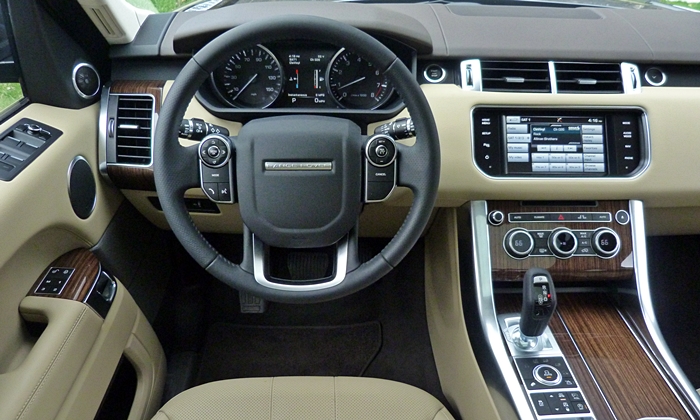
Shifter and touchscreen could be easier to use.
| Interior styling |
 Better
Worse
Better
Worse
|
Land Rovers and even Range Rovers didn't begin as luxury vehicles. As noted above, they were developed to perform certain tasks. But the company has never been a large one, and for a long time its plants were among the auto industry's least efficient. To turn a profit (or even get within a stone's throw of one), Land Rover had to charge relatively high prices. To justify these high prices, the interiors got nicer and nicer. The latest, like the exterior, manage to be at once classically British (fine wood, rich leather) and at the forefront of automotive design. You won't find as artful or as welcoming a cabin in a BMW SUV.
| Driving position & visibility |
 Better
Worse
Better
Worse
|
Land Rover holds that a high, commanding driving position is a crucial, defining element of its vehicles. Though there's decidedly more sport in the new Range Rover Sport, it retains such a driving position. You sit very high over a shallow instrument panel. Contrary to the current fashion, the windows remain large.
Still concerned about objects beneath the high base of the windows? The Range Rover Sport can be fitted with blind spot warning and an around-view camera system (though the latter cannot provide a single top-down image the way others can).
| Handling |
 Better
Worse
Better
Worse
|
If the Range Rover Sport didn't remain so strong in the make's traditional strengths, handling would rank higher among the reasons to buy one. I wasn't sure I'd enjoy driving the new Range Rover Sport. I ended up enjoying it a great deal. The base suspension BMW X5 feels sloppy, unwieldly, and artificial in comparison. I enjoyed driving it much less, a complete reversal of my 2006 experience. How did this happen?
To start, switching from a V8 to a supercharged V6 and from steel to aluminum construction has shaved over 700 pounds. This leaves a still substantial 4,700-plus (about the same as the BMW X5), but thanks to excellent steering and suspension tuning the new Range Rover Sport feels almost agile. It doesn't only not resist turning--it wants to turn. The steering, somewhat heavier than the new BMW X5's, is also more nuanced and naturally weighted.
Lean in hard turns? With the V6 at least, there's still a fair amount of it, if considerably less than before. No matter. The body might lean, but the RRS maintains your requested line with reassuring, even encouraging precision and composure. The centers of roll and rotation feel like they're exactly where they should be; this large, heavy vehicle feels like a natural extension of your body, no conscious adjustments required. Though both axles are constantly driven, the attitude of the chassis can be modulated with the throttle. Push the Range Rover Sport too far, and a sophisticated stability control system seamlessly intervenes. The entire package simply feels right.
The Range Rover Supercharged adds active stabilizer bars (to reduce lean) and torque vectoring (to further reduce the vehicle's already minimal understeer), so it should handle even better. A possible downside: the V8's additional weight over the front tires could reduce perceived agility and could be a reason why it gets torque vectoring while the V6-powered trims do not.
The new Range Rover Sport out-handled the X5 on the pavement even though it also remains more capable off the pavement. The standard air suspension can raise the RRS to increase its ground clearance. Unlike with the BMW, you can get a two-speed transfer case, and the tested vehicle was so equipped. The off-road package also includes a new automatic mode for the Terrain Response system, which offers specialized electronic systems calibrations for mud, sand, snow, and so forth. With so much capability, the Michelin Latitude Sport tires are likely the weakest link. If you're among the few people who'll take a Range Rover Sport well off the road, you might need a second set of wheels and tires for the task.
| |
Compared to the X5 |
| Price or payments |
 Better
Worse
Better
Worse
|
With such a fine combination of styling, luxury, and handling, why don't more people buy Range Rover Sports? This is an easy one: even compared to BMWs and the like they're expensive. The base RRS starts at $63,525. The tested modestly optioned HSE listed for over $73,000. (A 19-speaker Meridian audio system accounts for $1,950 of this. A contrasting roof color, which you can't get on a BMW, $650.) Add more options or step up to the V8-powered "Supercharged," and you can spend well over $80,000, even over $9,000. A similarly equipped X5 is over $5,000 less. Add options to both, and the gap widens.
| Reliability & durability |
 Better
Worse
Better
Worse
|
The second thing that has kept a lid on Land Rover sales has been a reputation for poor reliability. Unfortunately, TrueDelta has no data on the Range Rover Sport. What we do have on the LR3 and LR4 is mixed. With the LR4, owners haven't reported many problems during the first few years of ownership, but as I write this the picture for the 2011 and older isn't pretty. Maybe the latest ones will do better? Maybe, but it's a bet many potential buyers aren't willing to make given Land Rover's near-bottom rankings in reliability stats elsewhere.
I have a smidge more faith in the X5's reliability. While the X5 has traditionally been among BMW's least reliable models, no owners have reported repairs for the 2013 in our survey. And recently redesigned BMWs have been more reliable than those they replaced.
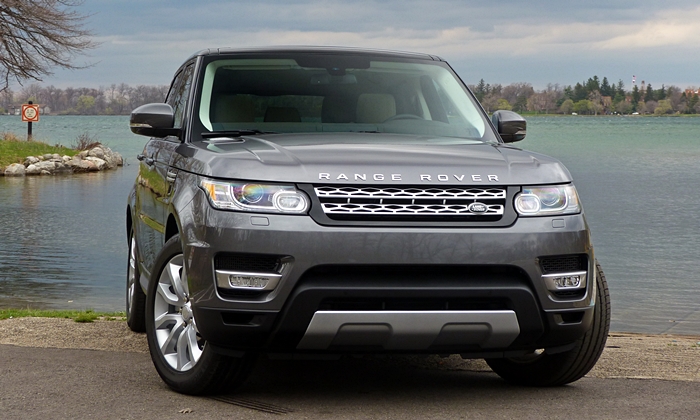
Road presence even without an over-sized grille.

Comfortable but not roomy rear seat. A big step up to get in.
| Controls and instruments |
 Better
Worse
Better
Worse
|
JLR's touchscreen-based infotainment interface is as needlessly fiddly in the RRS as it is in other Jaguars and Land Rovers. Undersized virtual buttons are often packed too tightly. This said, I could live with it.
| Cargo capacity |
 Better
Worse
Better
Worse
|
For a vehicle of its size and weight, the Range Rover Sport can't hold much cargo, with a maximum of 62 cubic feet. A Honda CR-V, though much smaller and lighter, can hold over 70 cubic feet. Blame the RRS's high load floor (a huge full size spare, part of the Tow Package, fits beneath it), intrusive suspension, and stylishly sloping roof line.
If you want more space for rear seat passengers or cargo, and are willing to give up style, luxury, and handling, Land Rover offers the LR4 (the taller, squarer body of which can hold 87 cubuc feet).
| Ride smoothness |
 Better
Worse
Better
Worse
|
In another reversal, the new Range Rover Sport has a choppier, noisier ride than the new BMW X5. But this says more about the latest BMW than the RRS, and I personally found the Range Rover Sport's ride sufficiently smooth and quiet even on Michigan's polar vertex-ravaged roads. The 255/55R20 Michelins effectively soak up even large bumps and deep potholes. But your tolerances and priorities might differ. Anyone seeking the smoothest, quietest ride won't find it here.
| |
Compared to the X5 |
| Front seat support & comfort |
 Better
Worse
Better
Worse
|
The Range Rover Sport's front seats are fairly comfortable, and their side bolsters can be adjusted to provide effective lateral support. But, compared to the BMW X5's multicontour front seats, their bottoms are overly hard and their headrests jut too far forward for my personal, relatively upright build (your experience could easily vary). Put another way, the seats aren't bad, but they don't feel as comfortable or as luxurious as the interior appears.
| Rear seat room & comfort |
 Better
Worse
Better
Worse
|
The Range Rover Sport's second row seat, higher off the floor and more comfortably contoured than that in the BMW, provides adults with adequate room and comfort. If you need generous rear legroom, though, you'll have to step up to the non-sport Range Rover.
An optional third-row seat (not on the tested RRS) deletes the spare tire and is very tight.
| Powertrain performance |
 Better
Worse
Better
Worse
|
With the redesign, a 340-horsepower supercharged 3.0-liter V6 has replaced the first-generation Range Rover Sport's 375-horsepower 5.0-liter V8. The lost 35 horses aren't missed, especially with the vehicle's curb weight reduced by over 700 pounds. I found the new engine easily quick enough. For those who want their large SUV to be brutally quick, a 510-horsepower supercharged 5.0-liter V8 remains available for another $9,000 or so.
On paper, the BMW's turbocharged six-cylinder engine is 40 horsepower weaker than the RRS's. In practice, it's at least as quick. BMW tends to under-rate its engines.
The engines' performance differs more subjectively than objectively. The Range Rover Sport's powerplant makes much more mechanical noise, and its power comes on less smoothly and linearly. I didn't mind this difference, even finding that the louder, less synthesized under-hood noises added character. But some people will prefer the quieter, more seamless power delivery of the BMW engine.
| Fuel economy |
 Better
Worse
Better
Worse
|
I'll end with a final surprise: fuel economy no longer ranks among the reasons not to buy a Range Rover Sport. Thanks to a lower curb weight, a more efficient engine, and two more gears in the transmission (for a total of eight), the Range Rover Sport's EPA ratings jump from last year's 13 mpg city and 18 mpg highway to 17 and 23, respectively.
This jump looks less impressive when compared to the 2014 BMW X5 xDrive35i's 18/27. But still impressive. Perhaps more of an issue: BMW offers the X5 with a diesel engine in North America, and its good for 23/31. Land Rover doesn't offer its diesels over here.
In my suburban driving, the Range Rover Sport's trip computer reported averages as high as 25. Even when I was making healthy use of the supercharger the average remained about 18. But the speed with which the gas gauge's needle traveled made me wonder whether the trip computer was accurate. My guess: it was about ten percent high.
The first-generation Range Rover Sport looked great, but guzzled gas and didn't handle well. The new one looks even better, no longer guzzles (with the V6), and easily out-handles the typical new BMW X5. The main downsides remain the same: a high price and questionable reliability. The latter might no longer be dismal--but this won't be knowable for a few more years.
If you can swing the price and the possibility of a repair ever year or so doesn't unnerve you, then the Range Rover Sport is the high-end midsize SUV to get. I've never been a big fan of Land Rovers in the past but, especially when combined with its smashing good looks, the experience of driving the new Range Rover Sport thoroughly won me over.
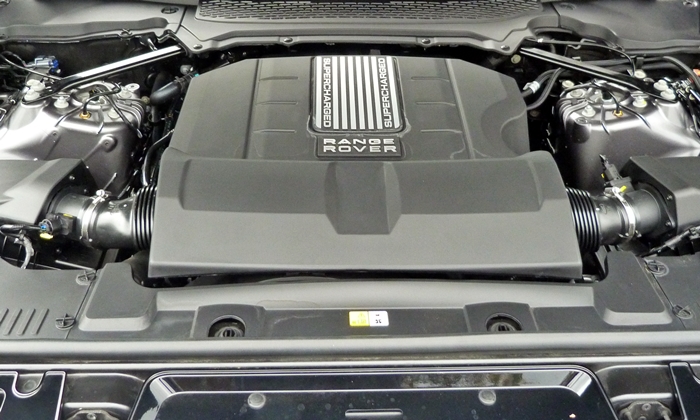
The new supercharged V6 is both powerful and efficient.
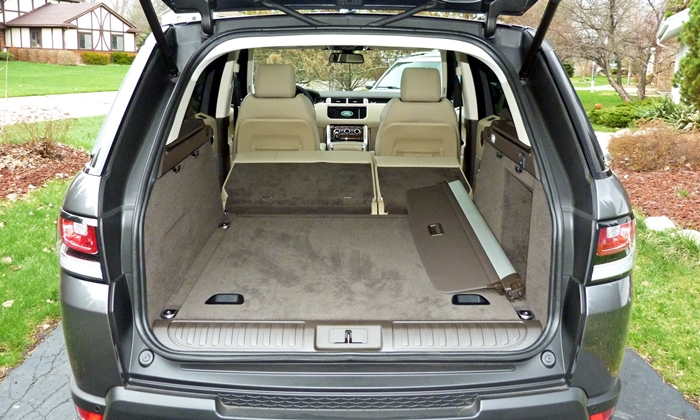
High floor contributes to less volume than in many compact crossovers. But how much do you need?
See more 2014 Land Rover Range Rover Sport photos
Land Rover and BMW each provided an insured vehicle for a week with a tank of gas.











